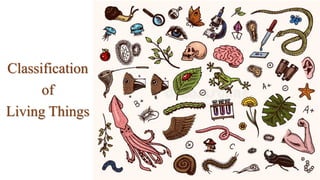
Classification chapter class fiv science
- 2. All living things have some characteristics which are the same and some which are different. This feature can help us to divide living things into two major groups, i.e. animal and plants. These are classified further into subgroups
- 3. Observe your surroundings and list a few different living things you will find, such as flowering plants, non-flowering plants, insects, birds and fish. Now, try to arrange them in groups on the basis of similarities and differences among them.
- 4. This categorization is called classification. It can be defined as a method use by scientists to order living organisms into different groups.
- 5. Therefore, scientists make a key to tell what organisms they are and which group the exactly belong to, and this is called a classification key.
- 6. Classification is essential because it helps scientists to identify organisms and break them down into groups. Five-kingdom classification
- 7. According to this systematic method, scientists classify living things into five main groups called kingdoms.
- 8. This classification is comprised of five kingdoms which are given below along with examples of living organisms that belong to these kingdoms. Let’s discuss each of them.
- 9. The Kingdom Monera consists of all bacteria. They are single-celled or unicellular organisms. They are present all around us, but not visible to the naked eye because they are microscopic in size.
- 10. Like plants, some bacteria can make their own food. At the same time, some depend on others and live in the bodies of other living organisms or dead bodies. They are dependent on other organisms in two ways.
- 11. Many bacteria get food directly from dead bodies.
- 12. Many bacteria make a relationship with the organism (host) whom they are getting food from.
- 13. Some of these bacteria cause disease in host organisms, while some are beneficial to them. Some are neither useful nor harmful to these organisms.
- 14. The best example of the kingdom Protista is algae. They can be unicellular, multicellular or colonial. Algae are found in ponds, rivers, lakes, etc.
- 15. They have the characteristics of both plants and animal as some of the algae can prepare their own food by the process of photosynthesis. Because they have chlorophyll. However, they are not classified as either of the two.
- 16. Euglena spirogyra volvox are examples of algae.
- 17. Kingdom Fungi
- 18. Fungi can be unicellular, multicellular, or filamentous (thread-like structures). Fungi cannot prepare their own food because they lack chlorophyll.
- 19. They grow in damp and moist places. They get their food from dead matter and cause disease in living organisms.
- 20. All organisms in this group are multicellular. They cannot prepare their own food so they depend on plants and other animals for their food. This is the largest kingdom and is classified further into two large groups.
- 21. Vertebrates have a vertebral column or backbone in their skeleton that helps them in movement and provides support. Different organisms have different structures of the vertebral column.
- 22. Invertebrates do not have a vertebral column or backbone. This group covers almost 97% of all known animal species on Earth.
- 23. Since they have no rigid support in the form of a backbone, they have another system which provides enough support to their bodies.
- 24. For example, invertebrates like insects have a hard outer shell for support. Their outer covering or shell is called exoskeleton, i.e. the skeleton outside the body which is made of chitin, a tough semi-transparent substance. Other examples are the jellyfish, earthworm, crab, octopus, starfish, etc.
- 25. Kingdom Plantae This kingdom consists of plants. They are multicellular organisms. They are also called autotrophs because they can prepare their own food. There are two main groups of plants, i.e. flowering and non- flowering plants.
- 26. Flowering plants have flowers on their stems. They produce seeds, which are enclosed in flowers or fruit. Rose, orange, apple, wheat, rice and sunflower plants are some of their examples.
- 27. Non-flowering plants do not have flowers on their stems. Conifers are examples of non- flowering plants. Their seeds are not enclosed in fruit or flowers. They have needle- shaped leaves which have seeds inside them. These leaves spread by wind or water, which helps in their reproduction. Most non- flowering plants reproduce by releasing large numbers of tiny spores.
